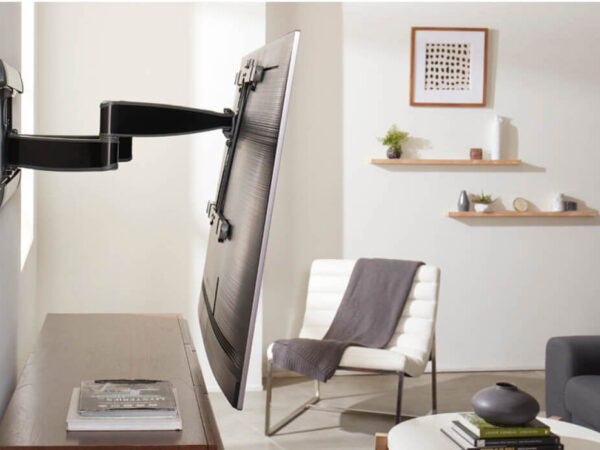When preparing to mount your beloved TV onto the wall, choosing the right wall mount bracket is absolutely essential. The mount acts as the supportive base that will securely hold your precious flatscreen in place for many years. But with so many types, styles and brands of TV wall mounts available, how do you select the optimal one?
We break down the common varieties of television wall mounting brackets and when to use each for the best safety, viewing angles and stability. Whether you are opting for professional TV mounting service or a DIY project, this blog is the right fit for you!
Fixed TV Wall Brackets
As the name suggests, fixed wall mounts anchor your TV flush to the wall without any wiggle room or adjustment capabilities. This basic TV bracket style simply holds your television in place at a fixed distance from the wall. Screws inserted into studs affix the wall plate, while your TV gets bolted onto the mount.
Best for:
- Smaller flatscreen TVs
- Secondary room TVs
- Wall insert installations
Perks:
- Streamlined simplicity
- Cost-effective price
- Slim 2” profile
Considerations:
- Limited adjustability
- Manual tilt installation
- Max VESA 600x400
Tilting Television Wall Brackets
A step up from fixed mounts, tilting brackets allow manually angling your TV screen up or down to direct the viewing angle. The single-joint arm offers +/-15 degrees of tilt range typically. This helps reduce glare and fine-tune height.
Best for:
- Bright room TVs
- Wall-mounted desks/monitors
- Angled ceilings
Perks:
- Wider range of motion
- Adapts viewing angle
- Leveling post-install
Considerations:
- Still partially fixed
- Not touchscreen friendly
- Max VESA 600x400
Full Motion TV Wall Mounts
Offering the most flexibility, full motion mounts give you the ability to tilt, swivel, retract and extend your television away from the wall. Ideal for larger TV sizes, the arm range of motion makes it easy to reduce glare and direct display positioning seamlessly.
Best for:
- Living room TVs
- Corner television mounting
- Above mantle installations
Perks:
- Fluid multi-axis adjustments
- Improves wall space usage
- Adapts for optimal viewing
Considerations:
- Pricier bracket type
- Overkill for secondary TVs
- Added complexity
Ceiling TV Mounts
Ceiling mounts attach above to the ceiling beams rather than the wall for suspending flatscreens from overhead. Extendable poles can lower TVs down to desired eye level.
Best for:
- Rooms with tall ceilings
- Showrooms/retail spaces
- Underneath decks & patios
Perks:
- Frees up wall space
- Adjustable height
- Statement showpiece
Considerations:
- Trickier installation
- Needs reinforced ceiling
- Pricier hardware
Corner TV Wall Brackets
Corner mounts secure TVs neatly into a room’s corner. Great for smaller spaces. The jointed arm hugs close into the corner while extending displays outward for angled corner viewing.
Best for:
- Small rooms/apartments
- Retaining wall space
- Unusual room layouts
Perks:
- Perfect small space solution
- Makes use of corner real estate
- Flexibly positions TV
Considerations:
- Limited to corner
- Visually heavier
- Not flush to wall
Conclusion
With such a wide variety of TV mounting bracket styles available, you can confidently find the perfect match to safely and beautifully display your beloved television on any wall or space.
Evaluate your TV size, ideal viewing needs, room arrangement and budget to select the ideal match. And rest assured once installed, you’ll enjoy television viewing from the perfect wall-mounted vantage point for years on end.
FAQs: Types of TV Wall Mounts
What is the most popular type of TV wall mount?
Full motion mounts are the most popular style by far for their fluid range of motion and ultimate adjustability. Their articulating arms extend, tilt, swivel, and rotate to achieve the optimal viewing angle in any room.
Should I get a fixed, tilting, or full motion TV bracket?
Consider your TV size, ideal viewing needs, room dynamics, and budget. Fixed mounts suffice for small secondary TVs that don’t require adjusting. Go tilting or full motion for living room main TVs to personalize positioning.
What tilt degree is best for a tilting wall mount?
The most common tilting wall brackets offer between 10–15 degrees of upwards and downwards tilt. This adequately directs the viewing angle for most standard height and distance living room installations without going overboard.
Can I hang my TV from the ceiling or corner instead?
Yes, specialty ceiling mounts and corner wall mounts specifically designed for those unique placements offer alternatives to centrally mounting on flat walls. Benefits include conserving wall space and flexibility.
How much weight can TV wall mounts hold?
Weight capacities range widely based on material, construction, and extensions. Fixed mounts support ~50 lbs, while reinforced full motion mounts safely hold 300+ lbs displays. Always check your TV weight and prospective mount’s weight rating.
What is VESA compatibility?
VESA refers to the universal screw patterns built into the back of flatscreen TVs that interface with wall mount brackets. So long as your mount matches your TV’s VESA sizing, they’ll connect together sturdily.
Finding the ideal match that fits your television size, room dynamics, viewing needs, and budget ensures a secure supportive TV mount installment that reliably displays your beloved flatscreen in style for years on end.

